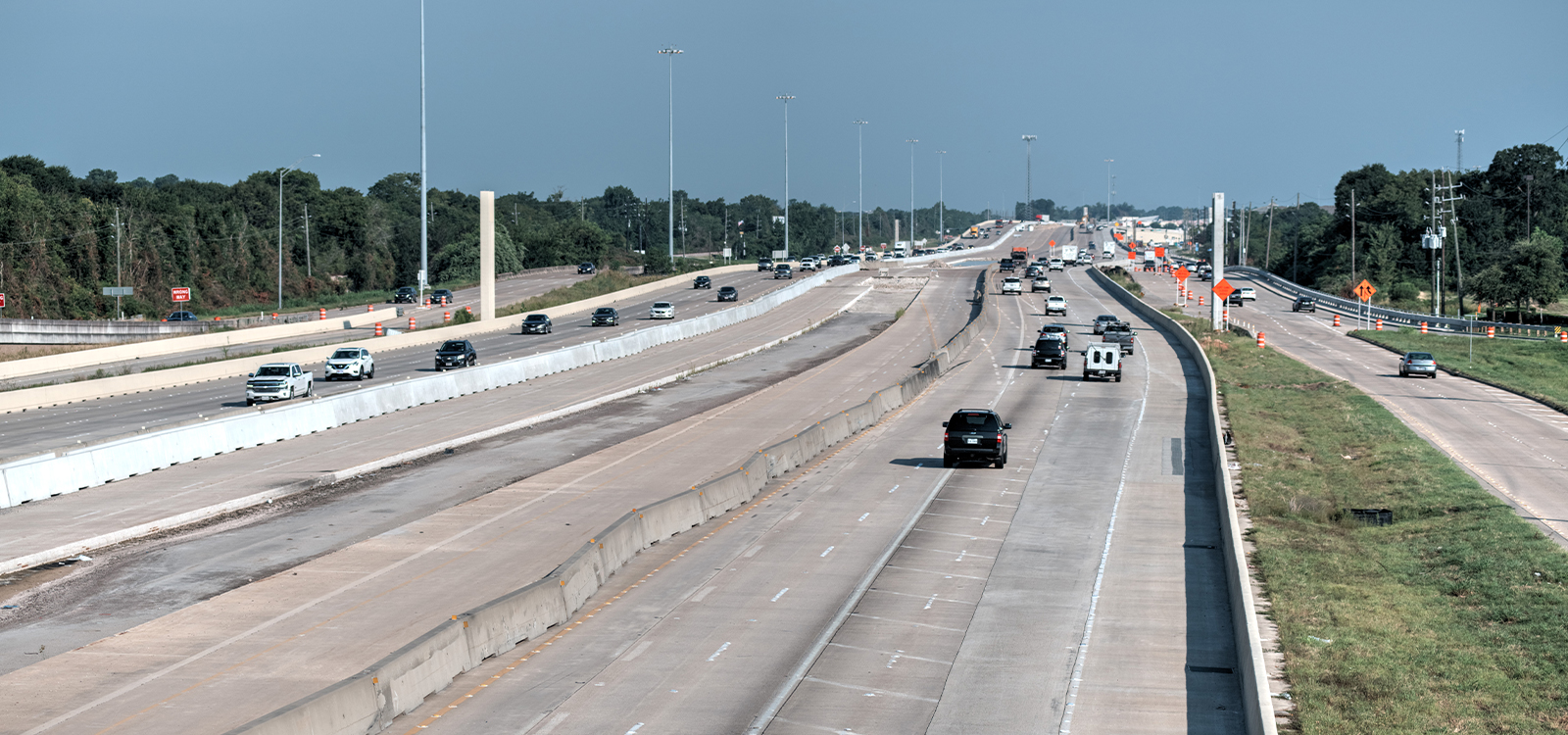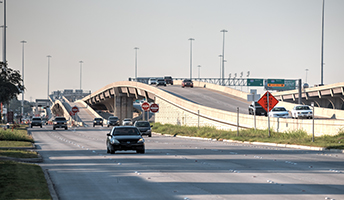Exceeding Expectations
Houston commuters will untie the bow on 38 miles of reconstructed and
widened main lanes of US Highway 290, 20 years ahead of schedule
DESIGNER
2018
Is it possible to launch a $2.4 billion highway reconstruction and improvement program in the heart of the country’s fourth largest city, without funding and, despite setback after setback, deliver it 20 years early?
In Texas it is.
After beginning 38 miles of improvements on US Highway 290 in 2006 and giving constituents a 2037 targeted completion date, the Texas Department of Transportation and program management consultant, HNTB, anticipate delivering the main lanes at the end of this year — a full 20 years ahead of schedule.
“Today, several portions of the new main lanes are open. As you get closer to the heart of Houston, inbound is complete, and outbound is almost complete. Projects in the suburban areas are done as well,” said LeAnne Napolillo, HNTB program manager.
Re-envisioning a corridor
US 290 is a major northwest spoke in the hub of highways that circle and radiate from downtown Houston. Despite three lanes in each direction, a reversible high-occupancy vehicle lane and a designation as a hurricane evacuation route, segments of US 290 ranked among Texas’ top 50 most congested roadways. If drastic improvements weren’t made to accommodate Houston’s ballooning population, the corridor could become too heavily congested, having a negative impact on corridor residents’ quality of life.
To improve conditions, TxDOT planned to enhance safety, capacity and mobility from the interchange of I-10/I-610/US 290 to near the Harris/Waller county line, a route traveled by more than 230,000 vehicles each day. Plans called for relocating the center HOV lane to a proposed, parallel managed lane facility, giving TxDOT room to add more general-purpose capacity to US 290.
Serving as an extension of staff
Co-locating with TxDOT, HNTB oversaw:
• Federal Highway Administration major project requirements
• Engineering design teams
• Project controls
• Public involvement
• Right-of-way acquisition
• Utility relocations
• Quality-assurance and quality-control standards
“We will continue to provide support for FHWA major project reporting and construction-phase services through the end of 2019,” Napolillo said.
“HNTB has the depth and breadth of experience to successfully deliver a major program,” said Said Haj-Khalil, TxDOT US 290 program manager. “We had multiple external challenges on this program. HNTB was able to handle the unexpected.”
Quieting Roads and Opposition
In public hearings, residents raised major concerns about noise from an expanded US 290. TxDOT responded with the state’s first use of quiet concrete pavement surface textures using the Next Generation Concrete Surface. The new concrete texture was applied to all main lane pavement along the US 290 alignment.
A diamond grinding and grooving process for surface texture provides a consistent profile with a predominantly negative texture, absent of positive or upward texture elements, according to the International Grinding and Grooving Association. The grooved surface minimizes textures and is expected to reduce tire noise by 75 percent.
Segmenting for best value
TxDOT launched the massive program with a design budget and consensus from numerous interest groups, including the
Metropolitan Transit Authority of Harris County, the Harris County Toll Road Authority, the cities of Houston and Jersey
Village, Union Pacific Railroad and the Houston-Galveston Area Council.
Using the available budget, TxDOT and HNTB divided the 38-mile alignment into 13 independent segments, each created to generate competitive bids. From there, the design team — TxDOT in-house staff and eight section design consultants — prepared “ready for letting” final design plans.
HNTB reviewed design plans of the eight section design consultants and coordinated with TxDOT in-house staff, who designed the five remaining segments. TxDOT planned to let the segments under design-bid-build procurement as more funding became available.
It was a smart decision. When funding arrived in the form of federal participation, agency partnership contributions and voter approved bond measures, the team was ready.
“We are grateful to voters,” Haj-Khalil said. “All phases of the US 290 program started on time or ahead of schedule.”
“TxDOT, HNTB and the engineering and contracting communities successfully partnered to overcome the challenges
of the accelerated construction schedule,” Haj-Khalil said.
Due to availability of funding, right-of-way acquisition, utility relocation and construction in many cases occurred simultaneously. Construction crews worked around utility crews who went to work as soon as a parcel of land was acquired. In all, TxDOT and HNTB would oversee 375 right-of-way acquisitions and 600 utility relocations.
“TxDOT’s flexibility, forethought and prioritization were keys to overcoming every obstacle — expected and unexpected,”
Napolillo said.

Retooling final plans
Other obstacles lie ahead, including the unexpected deferral of the planned managed-lane facility.
Relocating US 290’s existing HOV lane to the planned, parallel managed-lane facility was the program’s first order of business. With the HOV lane in its permanent home, TxDOT could dedicate US 290 to general-purpose traffic while complying with the final environmental impact statement.
Due to funding challenges, the ultimate vision for the US 290/Hempstead Corridor, which included construction of a new
location for the managed lane facility parallel to US 290, was not feasible at that time. TxDOT began construction in 2011, based on environmental approval of the ultimate vision, with a plan to complete the US 290 corridor by 2037. In 2012, TxDOT and Harris County executed a memorandum of understanding that defined an interim proposal that provided for construction of US 290 improvements with additional general-purpose capacity, and a managed lane component within the US 290 right-of-way and deferred the Hempstead construction. Based on the memorandum, TxDOT let 25 miles of US 290 for construction. In 2014, the County redefined the terms of the memorandum by ending their work on the interim concept.
“Resources and agency responsibilities were reallocated, and the recommended US 290 interim configuration was revised to reduce the overall cost,” Napolillo said. “Plans were revised to provide more interim improvements that could be incorporated into the long-term plan for US 290.”
“HNTB continues to provide consistent, knowledgeable, experienced staff,” Haj-Khalil said. “The team has handled urgent tasks with professionalism and met deadlines, which frequently include compressed schedules.”
Providing capacity, mobility, safety
The improved US 290, with enough new capacity to accommodate projected 2035 traffic volumes, will feature:
- Five general-purpose lanes in each direction from I-610 to west of State Highway 6
- Four general-purpose lanes in each direction from west of State Highway 6 to State Highway 99 (Grand Parkway)
- Three general-purpose lanes in each direction from State Highway 99 (Grand Parkway) to the Harris/Waller County line.
“The partnership between TxDOT and HNTB has mitigated challenges in delivering the US 290 program improvements decades ahead of the original schedule,” Haj-Khalil said. “It has been a successful journey toward a timely completion of the program.”
Eliminating Weaving
Direct connector ramps — from US 290 to Interstate 10 and another from I-10 to US 290 — greatly reduced traffic weaving movements on I-610 between US 290 and I-10, which only is a mile and a half. The ramps provide I-610 and I-10 motorists with their own roadways to make their movements.
At US 290 and Beltway 8, the construction of collector distributor roadways was a first for the Houston region. These roadways allow for exiting from and entering to the US 290 westbound and eastbound main lanes away from the heart of the interchange. This feature combines ramp movements, reducing disruption to the main lane traffic flow.
“The collector-distributor roads at the US 290/Beltway 8 interchange saved TxDOT from reconstructing the entire interchange,” Napolillo said.

CONTACT
Leanne Napolillo
HNTB's Program Manager
(713) 354-1553
[email protected]
SEE MORE ARTICLES
US 290 Program
INDYGO RED LINE
CASEY ARBORWAY
ALLEGIANT STADIUM
CHAMP CLARK BRIDGE
ORLANDO INTERNATIONAL AIRPORT, SOUTH TERMINAL
